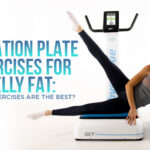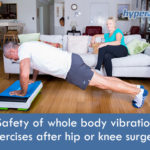Whole body vibration exercises can be used for different health and fitness goals, from massage and relaxation to recovery or building stronger muscles. Existing studies have shown that the outcomes are strongly influenced by the frequency and G-force used during the therapy or training session.
The proper frequency range for maximum muscle stimulation is 20-45Hz, for this reason most of the studies investigating the health impact of vibration training using frequencies above 20Hz. As for the G-force, studies have showed that for optimum muscle stimulation, a whole body vibration machine should deliver at least 5G of gravitational force.
Our Performance whole body vibration machine works at a frequency of 6-28Hz and delivers 0.8 – 17.4G of G-force, these parameters being ideal for both training and recovery purposes.
Both passive and active recovery have their role in the muscle repairing process after an injury, but it’s generally accepted that an early return to physical activity can accelerate recovery and facilitate the regeneration of the damaged muscle fibers. The problem is that lots of people find it difficult to start exercising after an injury, usually because they don’t feel strong enough to resume their training sessions, or they feel insecure and are afraid of getting injured again.
Whole body vibration can be a convenient and safe solution in such cases, as it requires minimum effort from the patient, is comfortable, and can be performed at home. Exercises done on a vibration platform can reduce pain, improve muscle strength, and speed up recovery, helping one move easier and feel better in a shorter time.
But how does vibration training help, more specifically? First, it helps in improving the flexibility of muscles and joints, reducing stiffness and restoring the normal degree of movement in the affected body area. These aspects are very important for recovery, as prolonged immobility can lead to muscle weakness and spasm, and can favor inflammation, delaying the recovery.
Then, WBV exercises increase the lymphatic drainage, speeding up the elimination of inflammatory substances from the site of injury, and improve circulation, allowing for better delivery of nutrients and oxygen to the damaged muscle cells. Better circulation and lymphatic drainage equal faster recovery, and the great thing is that vibration exercises are of low impact, unlike running or other cardio activities that can also improve the flow of blood and lymph but can be too painful and demanding for an injured individual.
Finally, exercises performed on a vibration machine warm up the muscles, and warmth has a soothing effect, helping one move more comfortably. This means that WBV can be used both as a warm-up solution and for facilitating recovery from an injury.
Besides supporting the regeneration of damaged muscle fibers, vibration therapy can also be integrated with rehabilitation programs. We’ll start with a paper published in the Journal of Neurotrauma, which discusses the effects of vibration training in spinal cord injuries.
The study was conducted on rats with SCI, by a team of researchers at the University of Cologne, Germany, and showed that 12 weeks of vibration training can improve the weight support during locomotion while restoring the density of synaptic terminals in the lumbar spinal cord and improving bladder function at 6-12 weeks post-injury.
These results were obtained for rats who were delivered the WBV treatment 14 days post-injury; starting the WBV treatment at 7 days post-injury did not lead to such improvements. Despite its limitations, this study does provide evidence that whole body vibration can help in the rehabilitation of patients with spinal cord injuries, and could be a non-invasive and inexpensive form of therapy for SCI.
A paper published in the journal of Disability and rehabilitation showed that vibration training may be effective in improving lower limb peripheral blood flow in people with spinal cord injury, and researchers at the Kinesiology Department at Texas Woman’s University in Denton, USA have found that whole body vibration can increase the bone mineral density in SCI patients.
Another interesting study from the journal of Physiotherapy Theory and Practice showed that vibration exercises can be effective in recovery after total knee arthroplasty, this form of training and therapy improving the strength of the knee extensor by 84.3% and the TUG score by 31%. The TUG (Timed Up and Go test) is a test that assesses a person’s mobility; the patient is asked to rise from a chair, walk 3 meters, then turn around, walk back to the chair and sit down.
In people with chronic stroke, whole body vibration can improve leg muscle activity, showed a study published in the journal of Medicine and Science in Sports and Exercise. Two different intensities were used for this study, each patient undergoing WBV therapy at 0.96G, respectively 1.61G of G-force.
Patients performed different exercises like squats, semi squats, upright standing, forward lunges, single-leg standing, and weight shifted backward, forward, or to the side. Both intensities led to improvements in the EMG activity in the paretic and nonparetic leg muscles.
All these studies suggest that vibration training can be a convenient, easy to use and safe alternative to conventional physical therapy, whether we refer to recovery from injuries or rehabilitation from various conditions.
Have something to add to this article? Comment below or join our Facebook community and share your thoughts with us!

The lymphatic system plays a crucial role in your bodily...

Simply put, your muscles contract and relax in response to...

If you keep hearing more about the vibration plate lately,...

If you are suffering from back pain or lower back...

Whole body vibration exercises may not seem the safest choice...